The ‘come and go’ campus conundrum Too many U of W and RRC Polytech students are still fleeing the inner city as soon as classes end
Read this article for free:
or
Already have an account? Log in here »
To continue reading, please subscribe:
Monthly Digital Subscription
$0 for the first 4 weeks*
- Enjoy unlimited reading on winnipegfreepress.com
- Read the E-Edition, our digital replica newspaper
- Access News Break, our award-winning app
- Play interactive puzzles
*No charge for 4 weeks then price increases to the regular rate of $19.00 plus GST every four weeks. Offer available to new and qualified returning subscribers only. Cancel any time.
Monthly Digital Subscription
$4.75/week*
- Enjoy unlimited reading on winnipegfreepress.com
- Read the E-Edition, our digital replica newspaper
- Access News Break, our award-winning app
- Play interactive puzzles
*Billed as $19 plus GST every four weeks. Cancel any time.
To continue reading, please subscribe:
Add Free Press access to your Brandon Sun subscription for only an additional
$1 for the first 4 weeks*
*Your next subscription payment will increase by $1.00 and you will be charged $16.99 plus GST for four weeks. After four weeks, your payment will increase to $23.99 plus GST every four weeks.
Read unlimited articles for free today:
or
Already have an account? Log in here »
Hey there, time traveller!
This article was published 28/12/2022 (1074 days ago), so information in it may no longer be current.
There are no traces of the University of Manitoba’s downtown campus, a collection of science and arts buildings that once stood where manicured grounds now host family picnics — and, during the winter months, piles of snow — on Memorial Boulevard.
Unless one believes an urban legend that suggests the stench of chemicals from the early labs, which were housed in a wooden facility that absorbed the scent before it was bulldozed, still emanate from the grounds on sweltering summer days.
More than 70 years ago, students and academics ditched U of M’s downtown site for a huge plot of land in Fort Garry. The school community fully vacated the campus in the city’s core, owing to growing enrolment, in 1950.
UNIVERSITY OF MANITOBA ARCHIVES An undated photo of the Science Building at the University of Manitoba’s downtown campus, which is now the current site of Memorial Park.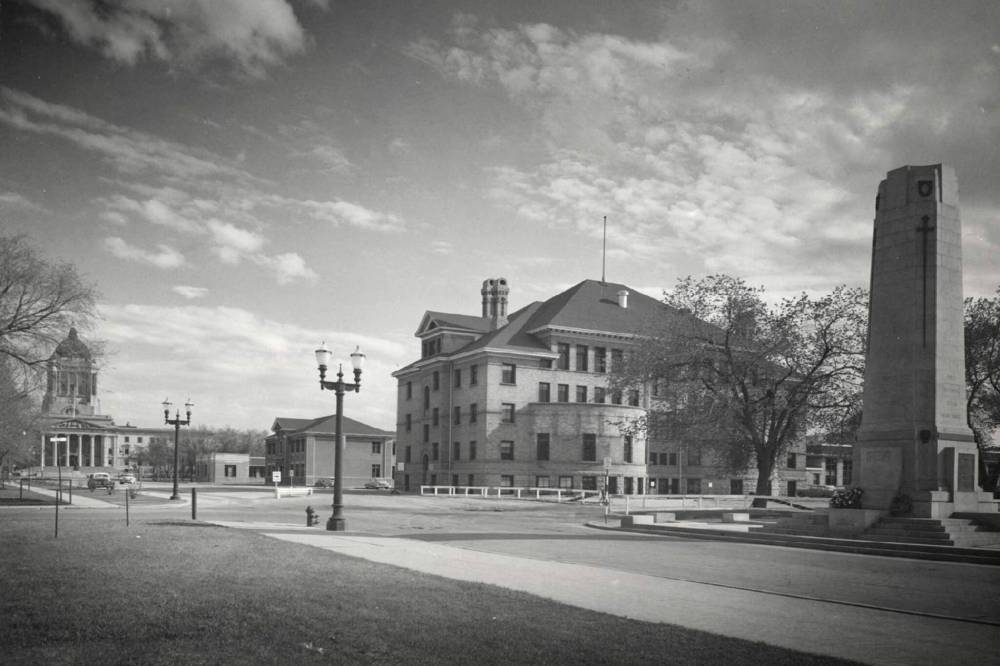
The decision to relocate in the suburbs was “one of the most unfortunate planning decisions in Winnipeg’s history,” as far as Jim Silver is concerned.
“Can you imagine what the downtown would be like if the 29,000 or so students at the (U of M) campus were to be located downtown?” said the veteran scholar and anti-poverty activist, who has worked on numerous inner-city projects throughout his career.
Today, the University of Winnipeg, Red River College Polytechnic and other central campuses combined draw about half of that total student population downtown throughout their busiest semesters.
Far from being “the city that never sleeps,” Winnipeg’s downtown has long had a reputation of emptying out after 6 p.m. — once white-collar workers flee their office buildings and scholars end their weekday lectures and labs.
The onset of the COVID-19 pandemic, along with the sudden popularity of remote work and distance learning, cemented its quiet reputation.
“Walking around in downtown at night, you don’t really feel that safe, so if there was a way to make it safer and make people more comfortable being here, I think that would go a long way,” said Kiratveer Singh Hayer, president of the University of Winnipeg Students’ Association.
“Walking around in downtown at night, you don’t really feel that safe, so if there was a way to make it safer and make people more comfortable being here, I think that would go a long way.”–Kiratveer Singh Hayer
Jonathan Henderson, a student leader who oversees UWSA external affairs, echoed those sentiments. Henderson said spotting a group of high-visibility vests — be they people gathering for a Bear Clan walk or another patrol — always puts him at ease.
Ask any other university or college student what would entice them and their peers to spend more time downtown and they will likely mention an improved sense of personal safety, too.
Gaming their way into urban planning
Winnipeg teachers want to turn pupils into urban planners with a new educational video game that will task users with exploring digital replicas of local landmarks and inserting infrastructure to better the downtown core.
A team made up of leaders from 10 school divisions, Microsoft and Winnipeg city hall are collaborating on Level Up: Winnipeg — the creation of a digital model of Manitoba’s capital in Minecraft, a hugely popular computer game in which users construct online worlds.
“Kids are using technology more than ever. The pandemic really heightened those online communities; lots of parents, myself included, were all owing our young ones to get on and to use those technologies to connect with peers and so, kids are coming to school with this wealth of (Minecraft) knowledge,” said Manny Skead, a teacher in the Louis Riel School Division.
Winnipeg teachers want to turn pupils into urban planners with a new educational video game that will task users with exploring digital replicas of local landmarks and inserting infrastructure to better the downtown core.
A team made up of leaders from 10 school divisions, Microsoft and Winnipeg city hall are collaborating on Level Up: Winnipeg — the creation of a digital model of Manitoba’s capital in Minecraft, a hugely popular computer game in which users construct online worlds.
“Kids are using technology more than ever. The pandemic really heightened those online communities; lots of parents, myself included, were all owing our young ones to get on and to use those technologies to connect with peers and so, kids are coming to school with this wealth of (Minecraft) knowledge,” said Manny Skead, a teacher in the Louis Riel School Division.
“That access point really helps kids who are both struggling in school and succeeding in school find common ground.”
The block-building and adventure game has become an increasingly common educational tool in classrooms across the province, as educators engage tech-savvy students and find innovative ways to offer authentic learning experiences.
In early 2021, Louis Riel and Microsoft, which owns the immersive gaming platform, launched an educational Minecraft universe that resembles The Forks before settlers arrived and colonized the area.
The Manito Ahbee Aki (“the place where the Creator sits”) game was designed to complement Manitoba’s Grade 4-6 social studies curriculum. Users learn about Anishinaabe culture, community and teachings while they explore, trade and hunt on pixelated grounds.
The successful collaboration prompted Microsoft to contact the division about the latest project. Winnipeg, Pembina Trails, Seven Oaks, River East Transcona, St. James-Assiniboia, Lord Selkirk and the francophone division, the Winnipeg Board of Jewish Education, and Manitoba Catholic Schools have since been recruited to take part.
The technology giant has already built Minecraft cities to mirror New York City, Stockholm and Calgary.
A spokeswoman for Microsoft Canada touted the Level Up: Winnipeg project as one that will connect youth to their city and help them learn to code and problem solve creatively.
“Canadian students have had a difficult few years; creating learning moments and fostering civic engagement through gaming will help them re-connect with their classroom and create excitement for the future they envision for Winnipeg,” said Elka Walsh, national education and skills lead for Microsoft Canada, in a recent news release.
The local edition will showcase the Exchange District, Manitoba Legislative Building and Circle of Life Thunderbird House.
Chris Heidebrecht, a member of LRSD’s school and classroom support team, said developers are using satellite imagery and photos to make sure their creations are to scale and host characters — non-playable characters or NPCs, in Minecraft lingo — will be digital representations of recognizable Winnipeggers.
“Minecraft is something familiar (to students) and so, they are coming in with a position of confidence and excitement. And when you can show them something that they’ve never seen before in the game, they’re immediately engaged and interested,” Heidebrecht said.
As with Manito Ahbee Aki, which the Winnipeg teacher helped design, the goal of the new Level Up: Winnipeg universe will be to teach students about both the historical and contemporary states of their city.
Once they have toured downtown, their challenge will be to use their newfound knowledge to build — be it affordable housing, bike lanes or anything else they think is lacking in the urban centre — in an empty plot depicting Winnipeg’s skyline in the background.
“It’s really prompting the students to think about where we’ve been as a city, and where we want to go,” Heidebrecht said, noting the final assignment is a short video of students showcasing their creation and explaining how it will contribute to the future of Winnipeg.
The prompt that will be posed to students is: “How can we envision a connected, equitable and sustainable downtown that moves Winnipeg forward without leaving anyone behind?”
Educators anticipate there will be cross-curricular lessons and rich discussion on the subjects of public space, transportation, urban sprawl, gentrification, sustainability, equity, and belonging. A teacher guide with ideas on how to embed the game into the classroom will be distributed provincewide.
LRSD students generally spend little time in the city’s core — separated from it by natural barriers: the Red and Assiniboine rivers — unless they are visiting for a Jets game, said Skead, an Indigenous education support teacher.
The educator said his hope is teachers will organize field trips to the inner-city so students can experience these iconic Winnipeg monuments online and on foot.
“We’re encouraging people to look at the broader sense of community… We also want to acknowledge and talk about the people that are in those spaces as human beings,” Skead added.
A draft version of the Minecraft world will go into beta testing in the new year. The official launch of Level Up: Winnipeg is scheduled for spring 2023.
maggie.macintosh@freepress.mb.ca
Twitter: @macintoshmaggie
These worries are nothing new. The U of W created its security escort program to address them in 1992; community members can now request either a pedestrian guide accompany them to a car or bus stop within a one-block radius of the central campus, or a driver drop them off to a location within downtown.
During all of 2018-19, the last school year unaffected by COVID-19, the program provided 137 walks and 49 rides.
So far in 2022-23, those figures are 236 and 49, respectively. A significant spike, although university administration indicated there has been increased promotion of an app that allows users to quickly request rides in 2022.
The reality is social issues are visible downtown and there is stigma attached to community members who are struggling, said Henderson, who completed his bachelor of arts in Indigenous studies at U of W and is enrolled in a conflict resolution degree program.
The student leader noted a group of people, who had set up camp in a bus shelter on the corner of Portage Avenue and Spence Street, was evicted last year due to safety concerns raised by students who take Winnipeg Transit.
At the same time, he said learners understand they have a role to play in looking after their neighbours who face hard times.
In partnership with Feast Bistro, UWSA’s hot meals program served more than 300 plates to community members experiencing homelessness last winter.
“We work on initiatives that provide opportunities for students to volunteer and also give back to the community because that’s very important in helping us maintain a healthy, safe community,” Henderson added.
The student association’s food bank, which serves scholars and the wider community throughout the year, recently resumed operations following a pandemic-related hiatus.
JOHN WOODS / WINNIPEG FREE PRESS The reality is social issues are visible downtown and there is stigma attached to community members who are struggling, said Jonathan Henderson, a student leader who oversees UWSA external affairs.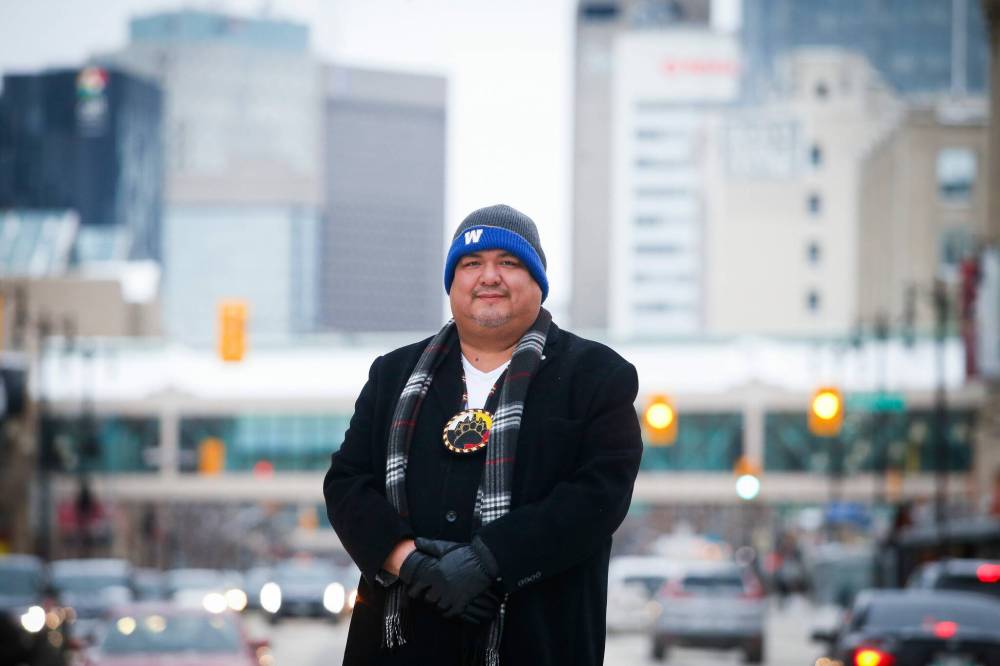
Alongside feeling belonging and familiarity, criminologist Michael Weinrath said social-psychological research suggests people feel safer when they are surrounded by others.
The U of W researcher’s findings suggest “most people feel pretty safe, most of the time,” and if anything, they are usually angry about crime or experience “vicarious fear” — they are worried about others rather than themselves.
Older people are typically more scared than their younger neighbours, and women are generally more afraid than men, per his research.
While Weinrath said high-profile homicides at The Forks and Millennium Library have made the public perceive downtown to be more unsafe than in the past, the professor — who started working at the U of W in 1997 — indicated the crime rate was far higher 25 years ago than it has been in recent years.
Statistics Canada data show the number of violent crimes per 100,000 residents in Winnipeg was about 1,623 in 1998. It was 1,483 in 2019 and slightly lower than that in 2021 (although public health orders limited overall social activity last year).
For Weinrath, the bigger barriers to attracting more people to the core on a regular basis are the introverted habits people picked up when they were forced to stay home at the height of the pandemic and the “come and go” culture.
“If you want to increase student presence, you need more residences. If you’re in a residence, you’re downtown. You’re stuck there and you will probably be more likely… to wander down to Portage Place or one of the sports bars or restaurants,” he added.
“If you want to increase student presence, you need more residences. If you’re in a residence, you’re downtown. You’re stuck there and you will probably be more likely… to wander down to Portage Place or one of the sports bars or restaurants.”–Michael Weinrath
Following an exam on a recent afternoon, Marienn Saria was waiting in a school cafeteria to pass the time before her ride arrived. The kinesiology student said she rarely lingers on and around campus, and certainly not after 5:30 p.m., if she does not have to anymore.
The 22-year-old indicated she wants to limit her close contacts to protect herself, her siblings and her parents. She commutes to and from her family home in Amber Trails.
But before March 2020 put face-to-face instruction on hold, Saria said she undertook adventures, especially in the Exchange District, to discover new areas and shops.
“Café hopping” between Thom Bargen Coffee Roasters on Kennedy Street and Forth Café on McDermot Avenue was among her favourite pastimes.
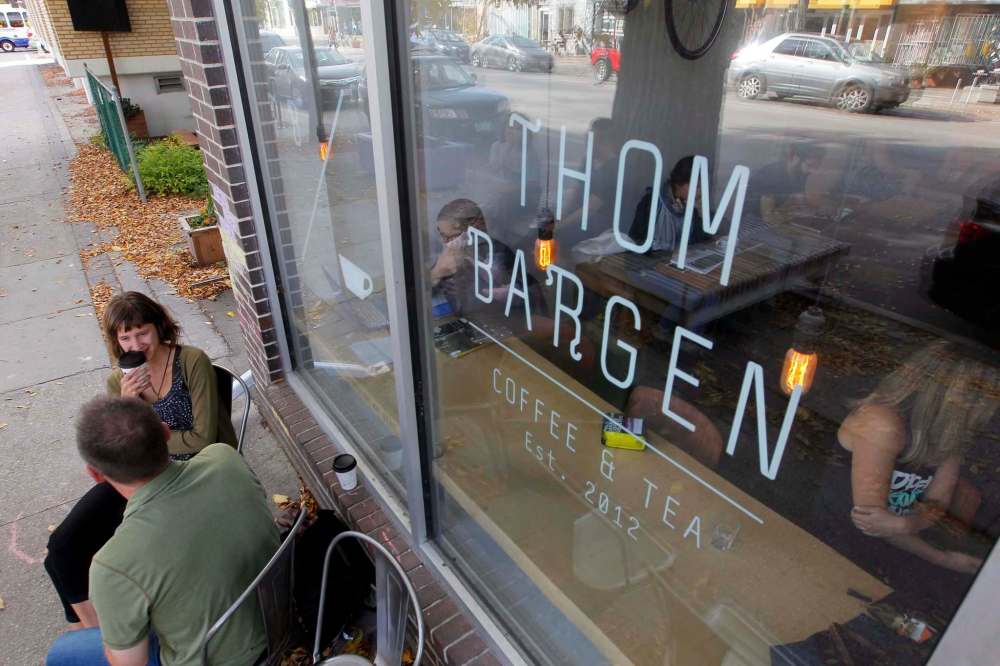
Forth Café, not unlike many neighbouring restaurants and storefronts, closed due to COVID-19-related issues. Other prime study and hangout spots, including the Second Cup on Edmonton Street and both the Starbucks and Garbonzo’s in the AnX, a student hub at U of W, did not survive the sudden drop in 2020 and 2021 foot traffic, either.
“These were places for students to de-stress and it was nice to have them available to us,” Saria said, adding there should be more promotion of remaining study spots to attract and retain students like her downtown before and after their scheduled lessons.
Another letdown was the decision by a Toronto developer, in September 2021, to back out of a massive project to revitalize Portage Place, which would have featured a student housing component.
Henderson, of the UWSA, however, said there are bright spots.
The student leader cited the Southern Chiefs’ Organization’s newly released plans to turn the Hudson’s Bay Co. flagship store into a multi-use building with hundreds of affordable housing units, and the survival of the Good Will Social Club, steps away from U of W.
“Students do take that pride and initiative in contributing to what our downtown is; an example was supporting Good Will to keep their doors open,” Henderson said.
“Students do take that pride and initiative in contributing to what our downtown is; an example was supporting Good Will to keep their doors open.”–Jonathan Henderson
Student union executives indicated they want to prioritize more events and support the resurgence of extracurriculars to re-engage students after several years in which public health orders limited campus life.
The expansion of UWSA’s daycare, a rare resource for parents who work or study downtown, is one of their major projects at present.
“My belief is that more investment in our downtown is the only way that we’re going to be able to address some of these issues that are causing concern among people who don’t live and work down there, and even those that do,” said Fred Meier, president and chief executive officer of RRC Polytech.
Meier called “creating momentum” between partners, including developers and industry leaders, the greatest challenge when it comes to expanding RRC Polytech’s Exchange District presence.
MIKE DEAL / WINNIPEG FREE PRESS FILES Fred Meier, President and CEO of RRC Polytech, called “creating momentum” between partners, including developers and industry leaders, the greatest challenge when it comes to expanding RRC Polytech’s Exchange District presence.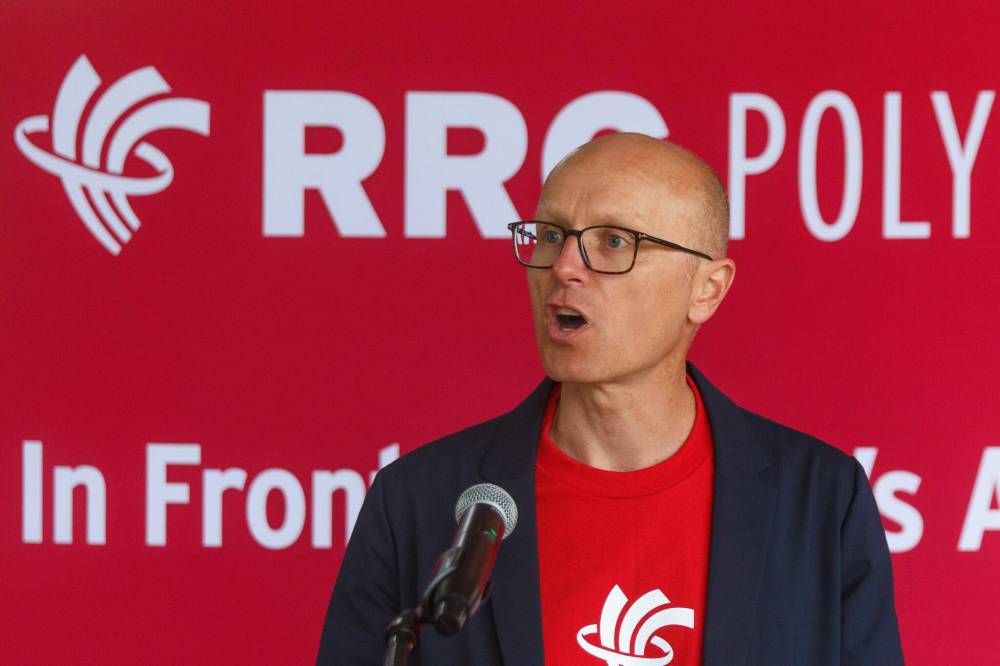
The opening of the institution’s newest facility, Manitou a bi Bii daziigae (an Ojibwa phrase that translates to “where Creator sits and brings light”), just over a year ago is evidence the school is invested in keeping up momentum, he said.
Since its downtown launch in 2002, the campus has expanded to three buildings from one.
The latest addition on Elgin Avenue houses 10 new programs, marking the most significant scale-up of the institution’s academic offerings in its history, and is surrounded by a new pedestrian corridor.
The so-called Elgin Plaza transformed the road between Princess and Adelaide Streets into an outdoor community space that can host food trucks, concerts and table tennis games — with granite structures and nets set up for students and downtown residents — and bridges the new building with the Roblin Centre.
The plaza will eventually connect the area to the Paterson GlobalFoods Institute, when the grounds of the former Public Safety Building become Market Lands, a mixed-use project with affordable housing, art studios and a public market, Meier said.
SUPPLIED The latest addition on Elgin Avenue houses 10 new programs, marking the most significant scale-up of the institution’s academic offerings in its history, and is surrounded by a new pedestrian corridor.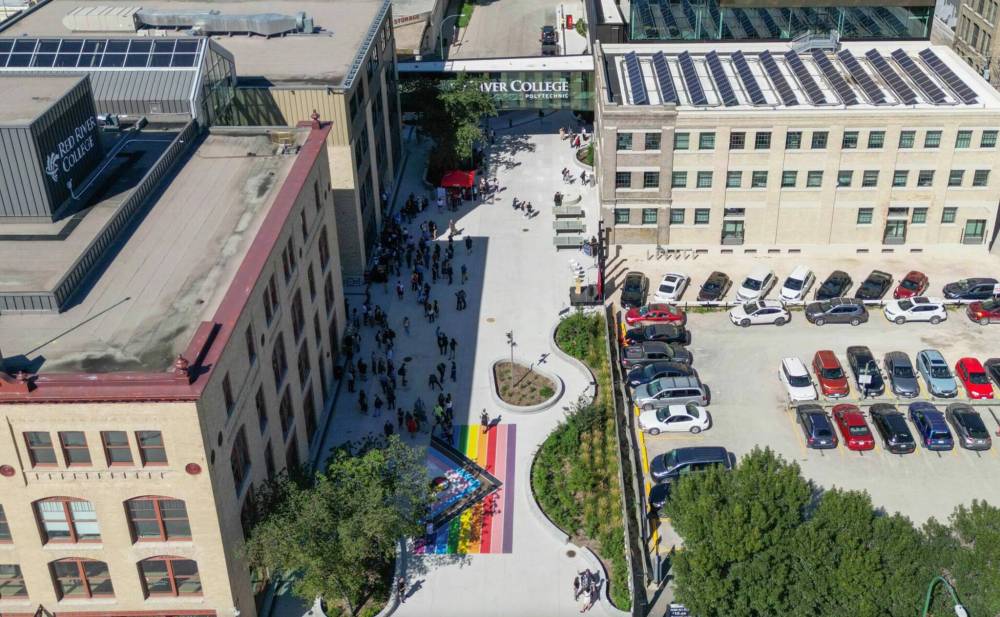
“Animating that space has changed our community. We know we’ve connected closer to the other residents that aren’t (staff) or students,” he said, noting RRC Polytech is focused on designing interior and exterior sites that are welcoming for all.
The outdoor ping-pong tables are currently covered in snow, but it is not uncommon for neighbours to bring their own paddles down in the summer and fall. The school is also exploring the installation of outdoor chess boards.
Downtown Winnipeg looks starkly different today than it did in the 1930s, when retired U of M vice-provost and professor Richard Johnson was growing up.
Johnson recalls there being lots of single houses, more trees and a doomed Broadway campus that was part of the downtown fabric.
Every Saturday evening, “Theatre A” — a former university facility located on Broadway — hosted public entertainment in the form of lawyer, doctor and professor lectures, he said, noting his father spoke fondly about the weekly, well-attended events.
“If the university had expanded so it was many, many blocks east to west and several blocks north to south, it might’ve stayed much as the Fort Garry campus looks now, (with) lots of students and lots of businesses,” he said.
Instead, the historical record shows the site’s demise can be attributed to too many students wanting to study downtown — a stark contrast to the problem city leaders are grappling with today.
maggie.macintosh@freepress.mb.ca
Twitter: @macintoshmaggie

Maggie Macintosh reports on education for the Winnipeg Free Press. Funding for the Free Press education reporter comes from the Government of Canada through the Local Journalism Initiative.
Our newsroom depends on a growing audience of readers to power our journalism. If you are not a paid reader, please consider becoming a subscriber.
Our newsroom depends on its audience of readers to power our journalism. Thank you for your support.
History
Updated on Wednesday, December 28, 2022 9:58 AM CST: Minor copy editing changes





